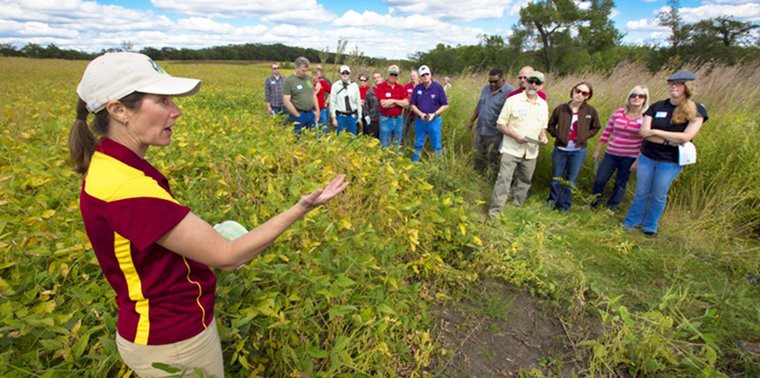May 1, 2018 —  Tallgrass prairie, and the rich diversity of plants and animals it supports, covered 150 million acres (61 million hectares) of the central United States when white settlers began plowing it under in the 19th century to make room for crops. In today’s agriculture-dominated Midwest and eastern plains, about 4 percent of that prairie remains.
Tallgrass prairie, and the rich diversity of plants and animals it supports, covered 150 million acres (61 million hectares) of the central United States when white settlers began plowing it under in the 19th century to make room for crops. In today’s agriculture-dominated Midwest and eastern plains, about 4 percent of that prairie remains.
Now, a team of Iowa State University researchers, educators and extension agents is turning up evidence that weaving strips of prairie into row-crop farms can provide valuable wildlife habitat while blunting some of the worst environmental impacts of modern agriculture in the midwestern U.S.
Those impacts are significant. Excess nutrients from fertilizers and manure have fueled a New Jersey–size “dead zone” in the Gulf of Mexico, sparked legal fights in Iowa about polluted drinking water and blanketed parts of the Great Lakes in algae. At the same time, corn and soybean fields displace grassland habitat for wildlife and are sloughing off soil at an unsustainable rate.
“All of these are concerns for people who own land, who farm, who live in these landscapes,” says Matt O’Neal, an associate professor of entomology at Iowa State who has been part of the research team for about a decade. “There are a bunch of solutions for any one of them. But what makes prairie strips really cool is that a single practice can address all of them.”
In a paper published last year in the Proceedings of the National Academy of Sciences, the group reported a decade’s worth of data showing that covering just 10 percent of cropland in prairie strips — planted in ribbons about 20 to 30 feet (6 to 9 meters) wide, perpendicular to the land’s slope as a barrier to runoff — cut soil loss from fields where they were planted by 95 percent and reduced phosphorus and nitrogen runoff by 77 and 70 percent, respectively. The strips also more than doubled the abundance of birds and pollinators.
The researchers also found that the strips didn’t cost as much as many other conservation practices, and did not reduce yield in the area planted in crops. Nearly 50 farms have planted prairie strips in Iowa, Illinois, Michigan, Missouri and Wisconsin, and a handful more will soon join them. Those growers want to be good stewards of their land, the researchers say, and see prairie strips as an affordable conservation tool that may ultimately help their bottom line by boosting soil health and attracting beneficial insects. Many farmers can offset the cost of strips by enrolling them in farm bill conservation programs and by using GPS and other technology to plant prairie in a field’s least productive areas.
As more farmers adopt prairie strips, research into their benefits continues. Some team members, for instance, are investigating strips as a way to halt the spread of antibiotic-resistant microbes. O’Neal and collaborators, meanwhile, are conducting research that suggests nectar- and pollen-rich prairie strips may help honeybees — and, presumably, native pollinators — survive winter by maintaining a healthy weight after crops stop flowering.
Though not the main selling point for using prairie strips, the benefit to pollinators is well worth noting, O’Neal says.
“If prairie strips are a hamburger, the nutrient reduction is the meat, soil erosion is the bun, and the sesame seeds on the top of that bun—that’s improvements for honeybees,” he explains. “It’s not going to sell you the hamburger, but it makes it look even better.” ![]()
Ensia shares solutions-focused stories free of charge through our online magazine and partner media. That means audiences around the world have ready access to stories that can — and do — help them shape a better future. If you value our work, please show your support today.
Yes, I'll support Ensia!
